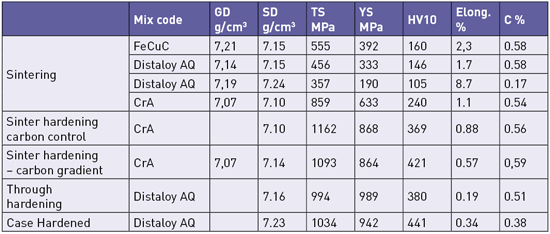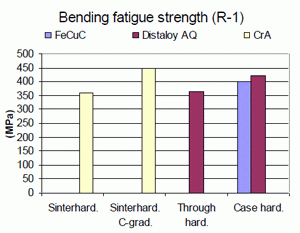Euro PM2012: Optimising the material and Powder Metallurgy route to small engine connecting rods
Sigurd Berg and his colleagues at Höganäs AB, Sweden, presented a paper at EuroPM2012 (Basel, September 16-19) which focused on the influence of sintering and different heat treatment processes on static and dynamic properties of three ferrous PM alloys for small engine connecting rods.
The selection of the material and the production process that when combined give the best cost/performance ratio is a very important factor in determining the preferred technology for a particular application. This is especially the case for critical automotive components such as engine connecting rods which need not only to meet the demands of cost but also high performance properties and close tolerances.
To achieve this for small engine connecting rods, Sigurd Berg, Ulf Engström, and Caroline Larsson at Höganäs AB in Sweden undertook a study of three different ferrous powders, admixed FeCuC, diffusion bonded Distaloy AQ, and prealloyed Astaloy CrA (Table 1).

Table 1 Chemical compositions of the ferrous PM materials studied to optimize PM processing of small engine connecting rods. (From paper by S. Berg, etal. ‘Material and Process Optimization for a Small Engine PM Connecting Rod’, presented at EuroPM2012, Basel, September 16-19, and published in the Conference Proceedings by EPMA)
These powders were mixed with 0.8% Amide wax pressing lubricant and graphite, and at least 500 connecting rods were compacted from each material at 700 MPa in a 400 ton Lauffer press. Dimensions of the as-pressed connecting rod are a total length of 82.25mm and a centre distance of 58.60mm at half of the height for the connecting rod. Dimensions were measured by taking 5 after each compacted 50 connecting rods using a Zeiss Duramax coordination rig.
Sintering of the FeCuC and Distaloy AQ compacts was done in a mesh belt furnace at 1120°C for 30 min using 90N2/10H2 atmosphere with 0.2% methane addition for carbon control. The Astaloy CrA material was sintered using the same settings as for the other two materials, but using rapid cooling to achieve sinter hardening. The rapid cooling rate of 3-5°C/s is obtained by increasing the gas velocity and cooling down the gas in the cooling zone. Carbon potential was set by 0.2% methane addition to the sintering atmosphere.
The Astaloy CrA material was also sintered using pure N2 with addition of natural gas to obtain a CO content of 0.1%. This was done to create a carbon gradient in the test specimens and connecting rods. The rapid cooling rate was again set to 3-5°C/s. All sinter hardened specimens and connecting rods were tempered at 200°C for 60 minutes in air.
The sintered Distaloy AQ connecting rods with a carbon potential of 0.6% were subsequently heat treated by through hardening at 860°C for 20 minutes, followed by tempering at 200°C in air for 60 minutes. Case hardening was also done on Distaloy AQ having a slightly higher carbon potential of 0.8% at 860°C for 20 minutes, followed by tempering at 200°C in air for 60 minutes.
Mechanical and dynamic properties
Berg and his colleagues compared results for mechanical properties in the sintered, sinter hardened and heat treated states (Table 2), and also investigated the fatigue performance of the three PM alloys.

Table 2 As-sintered, sinter hardened and heat treated properties of FeCuC, Distaloy AQ and CrA ferrous PM materials. (From paper by S. Berg, etal. ‘Material and Process Optimization for a Small Engine PM Connecting Rod’, presented at EuroPM2012, Basel, September 16-19, and published in the Conference Proceedings by EPMA)

Fig.1 Fatigue strength of sinter hardened and heat
treated connecting rods. (From paper by S. Berg, etal.
‘Material and Process Optimization for a Small Engine PM
Connecting Rod’, presented at EuroPM2012, Basel,
September 16-19, and published in the Conference
Proceedings by EPMA)
Fatigue testing was done in four-point bending fatigue tests using as-compacted un-notched ISO 3928 test bars modified with a chamfer. It was found that the sinter hardened Astaloy CrA material gave a higher tensile strength at 1162 MPa and 1093 MPa for the carbon gradient CrA material compared to the heat treated Distaloy AQ material. However, the yield strength is lower. Elongation for sinter hardening with carbon control (0.88%) is higher than for the through hardening Distaloy AQ (0.19%), and with carbon gradient sinter hardening the elongation is 0.57% compared to 0.34% for the case hardened material.
The fatigue strength, σ50 at R=-1 for investigated materials in different processes is shown in Fig 1. Astaloy CrA sinter hardened with carbon control has a similar fatigue strength (364MPa) to through hardening Distaloy AQ. Sinter hardened CrA with carbon gradient has slightly higher fatigue strength (447MPa) than conventional case hardening of FeCuC and Distaloy AQ.
Results from the stress analysis are shown in Fig. 2. The peak stress occurs at the inner radius of the stem at the big end and is σnorm=28.7 MPa/kN .

Fig.2 Model for stress analysis (left) and results from stress analysis with 1 kN axial unit load (right) (From paper by S. Berg, etal. ‘Material and Process Optimization for a Small Engine PM Connecting Rod’, presented at EuroPM2012, Basel, September 16-19, and published in the Conference Proceedings by EPMA)
Cost impact
It is clear from the results presented by the authors that sinter hardened CrA and also the sinter hardened CrA with the carbon gradient give higher performance properties than the heat treated material. This is also true for elongation values which the authors attribute to the 2% Ni content in the CrA powder. The use of nickel does increase the cost of the raw material but because of the combination of sintering+hardening in the same process, the overall cost is reduced compared with separate sintering and heat treatment steps.
The authors estimate that the cost for sintering FeCuC is €3.25/kg, the cost for sintering + heat treatment Distaloy AQ is €3.53/kg, and for the sinter hardening CrA material the total cost is just €2.11/kg. Compaction and other costs other than sintering, sinter hardening and heat treatment are not included in the comparison.
Sigurd stated that influence of sintering atmosphere composition influence on cost, if it is normalized to 95/5 N2/H2 , is for N2+natural gas = 79%, 90/10 = 124% and 97/3 = 90%. As stated above the atmosphere used for the sinter hardening process was 90/10 N2/H2 with 0.2% methane addition, or nitrogen with natural gas addition to obtain 0.10% in CO content.
Overall gas consumption was said to be 9 Nm3/hr. Methane addition gives carbon control, but no carbon gradient at the surface. The natural gas atmosphere does, however, provide a carbon gradient resulting in the higher fatigue performance. This atmosphere composition also offers a cost advantage by a reduction of around 35% in gas consumption cost.
News | Articles | Market reviews | Search directory | Subscribe to e-newsletter





